NVIDIA Single Card, Multi-GPU: GeForce 7950 GX2
by Derek Wilson on June 5, 2006 12:00 PM EST- Posted in
- GPUs
Splinter Cell: Chaos Theory Performance
For this test, we once again used the built in lighthouse benchmark and scripts originally created at Beyond3d. For this benchmark, it is important to note that the non-AA numbers enable PS3.0 features, while the benchmarks with AA do not (as these two options are not supported simultaneously in-game). At low resolutions, SC3 absolutely benefits from multi-GPU solutions, and so shows a nice performance advantage for 7950 GX2. With either the HDR features available under PS3.0 rendering or 4xAA for smoothing the jaggies, the new NVIDIA card is the king of the hill. Like Half-Life 2, though, we would suggest that the performance increase at low resolutions isn't yet enough to warrant a $600 graphics solution if you are monitor limited to 1280x1024.
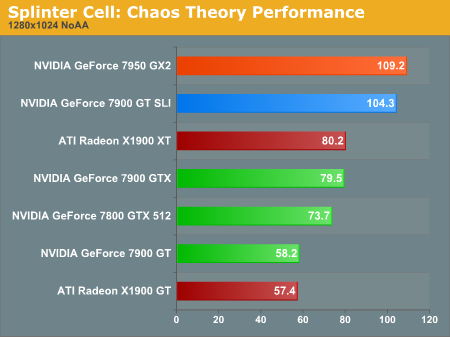
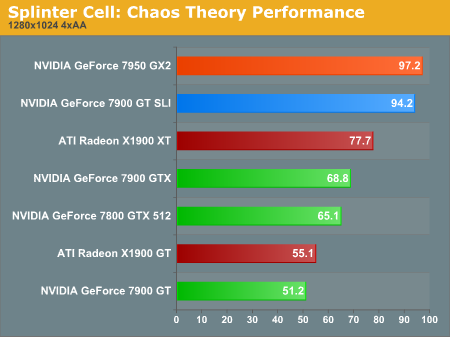
Increasing resolution shows us no change in the performance characteristics between the 7950 GX2 and the rest of the pack.
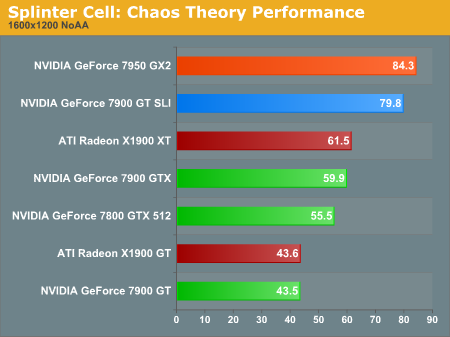

At the highest resolution we tested today, it's clear that 7950 GX2 is the way to go in order to get the best SM3.0 and HDR experience. Interestingly, the Radeon X1900 XT closes the gap a little bit under 4xAA settings as resolution increases. The 7950 GX2 still comes out on top, but SC3 is a game that really shines on ATI hardware as well.
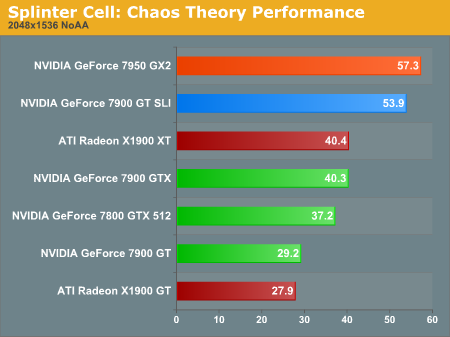
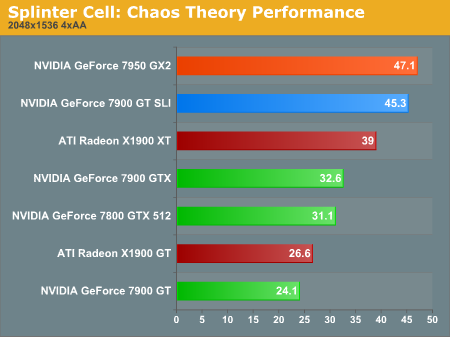
For this test, we once again used the built in lighthouse benchmark and scripts originally created at Beyond3d. For this benchmark, it is important to note that the non-AA numbers enable PS3.0 features, while the benchmarks with AA do not (as these two options are not supported simultaneously in-game). At low resolutions, SC3 absolutely benefits from multi-GPU solutions, and so shows a nice performance advantage for 7950 GX2. With either the HDR features available under PS3.0 rendering or 4xAA for smoothing the jaggies, the new NVIDIA card is the king of the hill. Like Half-Life 2, though, we would suggest that the performance increase at low resolutions isn't yet enough to warrant a $600 graphics solution if you are monitor limited to 1280x1024.


Increasing resolution shows us no change in the performance characteristics between the 7950 GX2 and the rest of the pack.


At the highest resolution we tested today, it's clear that 7950 GX2 is the way to go in order to get the best SM3.0 and HDR experience. Interestingly, the Radeon X1900 XT closes the gap a little bit under 4xAA settings as resolution increases. The 7950 GX2 still comes out on top, but SC3 is a game that really shines on ATI hardware as well.












60 Comments
View All Comments
JarredWalton - Monday, June 5, 2006 - link
Yes, SLI profiles are used for full utilization of the GX2 card. (AFAIK - Derek can correct me if I'm wrong.)DerekWilson - Monday, June 5, 2006 - link
SLI profiles are used if availalbe, but SLI profiles are never required to enable multi-GPU support on NVIDIA hardware.there are some advanced options for enabling multi-GPU or single-GPU rendering in the control panel -- even down to the AFR or SFR mode type (and SLIAA modes as a fallback if nothing else will work for you).
in short -- required: no, used: yes.
araczynski - Monday, June 5, 2006 - link
haven't read the article yet as I didn't see reference to Oblivion benchmarks, and lets be honest, that's the only game out these days that's worth benchmarking (in terms of actually giving the high end cards an actual workout).DigitalFreak - Monday, June 5, 2006 - link
It's amazing all the cool stuff you can do with PCI Express.Sniderhouse - Monday, June 5, 2006 - link
The Voodoo5 5500 had two GPUs on a single card which did true SLI, not to mention the Voodoo5 6000 which had four GPUs, but never really made it to market.
shabby - Tuesday, June 6, 2006 - link
The x24 was also a dual pcb video card, thats what he meant. Not dual chip or whatever.timmiser - Monday, June 5, 2006 - link
Exactly what I was thinking!DerekWilson - Monday, June 5, 2006 - link
Perhaps I should have said successful products ... or products that were availble in any real quantity :-)photoguy99 - Monday, June 5, 2006 - link
From page 1, what limitations are being referred to?Ryan Smith - Monday, June 5, 2006 - link
DX9 itself has a good deal of overhead in some situations, something Microsoft is changing for DX10. We'll have more on that in our upcomming Vista article later this week.